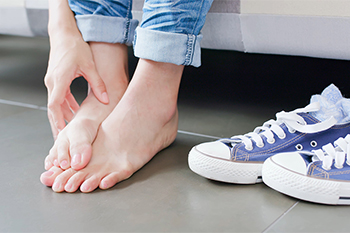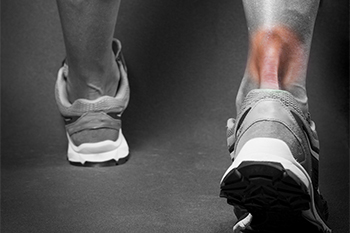Middlefield (860) 349-8500
Wallingford (203) 294-4977
Middlefield (860) 349-8500
Wallingford (203) 294-4977

There are a number of foot afflictions that can occur when a bone in the foot, no matter how small, dislocates from its proper place. Cuboid syndrome is one such condition. Cuboid syndrome occurs when the cuboid bone, located in front of the ankle, dislocates randomly or in response to some kind of injury. If you have cuboid syndrome, you might experience pain, particularly when participating in weight-bearing activities. Additionally, you might find yourself turning your feet inward when walking if you are suffering from cuboid syndrome. There are several ways in which cuboid syndrome can be treated. Commonly, the cuboid bone can be manipulated back in place by a medical professional. The medical professional might then use tape and custom orthotics to keep the cuboid bone in its proper place. Also, the effects of cuboid syndrome can be addressed with specific massages. For example, deep tissue massages that target the calf muscles can be used on patients to calm the peroneal muscle. As a result, the amount of pressure that your feet place on the cuboid bones can be reduced. If you believe that you might have cuboid syndrome, it is a good idea to reach out to a podiatrist who can help you tackle the problem.
Cuboid syndrome, also known as cuboid subluxation, occurs when the joints and ligaments near the cuboid bone in the foot become torn. If you have cuboid syndrome, consult with Dr. Gordon Fosdick from Affiliated Foot Care Center. Our doctor will assess your condition and provide you with quality foot and ankle treatment.
Cuboid syndrome is a common cause of lateral foot pain, which is pain on the outside of the foot. The condition may happen suddenly due to an ankle sprain, or it may develop slowly overtime from repetitive tension through the bone and surrounding structures.
Causes
The most common causes of cuboid syndrome include:
Symptoms
A common symptom of cuboid syndrome is pain along the outside of the foot which can be felt in the ankle and toes. This pain may create walking difficulties and may cause those with the condition to walk with a limp.
Diagnosis
Diagnosis of cuboid syndrome is often difficult, and it is often misdiagnosed. X-rays, MRIs and CT scans often fail to properly show the cuboid subluxation. Although there isn’t a specific test used to diagnose cuboid syndrome, your podiatrist will usually check if pain is felt while pressing firmly on the cuboid bone of your foot.
Treatment
Just as the range of causes varies widely, so do treatments. Some more common treatments are ice therapy, rest, exercise, taping, and orthotics.
If you have any questions, please feel free to contact our offices located in Middlefield and Wallingford, CT . We offer the newest diagnostic and treatment technologies for all your foot care needs.

There are several types of fungi that are classified as dermatophytes which can cause skin infections, including athlete’s foot. There are different types of athlete’s foot, and each have their own symptoms. The most common form of athlete's foot is called chronic interdigital athlete’s foot, and the skin is generally itchy between the fourth and fifth toes. It can develop by wearing shoes that are too tight, creating a moist environment that can encourage fungal growth. Chronic scaly athlete's foot, which is also referred to as moccasin-type, can be found on the sole of the foot. The skin is typically dry, and underneath it can be pink and tender. The least common type of this kind of skin infection is referred to as acute vesicular athlete’s foot. The symptoms that are associated with this can consist of blisters that develop on the bottom or top of the foot, and is caused by multiple fungi. Athlete's foot is considered to be contagious, and it is advised to wear appropriate footwear while in public swimming pools, locker rooms, and standing on shower room floors. If you have signs of this skin infection, please consult with a podiatrist as quickly as possible who can start you with the appropriate treatment.
Athlete’s Foot
Athlete’s foot is often an uncomfortable condition to experience. Thankfully, podiatrists specialize in treating athlete’s foot and offer the best treatment options. If you have any questions about athlete’s foot, consult with Dr. Gordon Fosdick from Affiliated Foot Care Center. Our doctor will assess your condition and provide you with quality treatment.
What Is Athlete’s Foot?
Tinea pedis, more commonly known as athlete’s foot, is a non-serious and common fungal infection of the foot. Athlete’s foot is contagious and can be contracted by touching someone who has it or infected surfaces. The most common places contaminated by it are public showers, locker rooms, and swimming pools. Once contracted, it grows on feet that are left inside moist, dark, and warm shoes and socks.
Prevention
The most effective ways to prevent athlete’s foot include:
Symptoms
Athlete’s foot initially occurs as a rash between the toes. However, if left undiagnosed, it can spread to the sides and bottom of the feet, toenails, and if touched by hand, the hands themselves. Symptoms include:
Diagnosis and Treatment
Diagnosis is quick and easy. Skin samples will be taken and either viewed under a microscope or sent to a lab for testing. Sometimes, a podiatrist can diagnose it based on simply looking at it. Once confirmed, treatment options include oral and topical antifungal medications.
If you have any questions, please feel free to contact our offices located in Middlefield and Wallingford, CT . We offer the newest diagnostic and treatment technologies for all your foot care needs.

The long tendon that connects the heel bone with the calf muscles is called the Achilles tendon. The Achilles tendon is a critical component in running and walking, making it prone to wear injuries that can affect anyone. However, track and field athletes and those who play volleyball, softball, soccer, or racquet sports are more susceptible to these injuries. Pain in the lower calf, or at the back of the ankle may be indicative of an Achilles tendon injury. A common inflammatory injury to the Achilles tendon is tendonitis, which can cause sudden pain. Paratenonitis is another type of inflammatory issue which causes the covering of the Achilles tendon to thicken and inflame, thereby restricting the tendon’s movement. Tendinosis is a degenerative condition which weakens fibers in the tendon. Insertional Achilles Tendinopathy starts out with an inflammation of tendon fibers that attach to the heel bone, and then later degenerate. Athletes with any of these issues would do well to make an appointment with a podiatrist for proper diagnosis and treatment.
Ankle and foot injuries are common among athletes and in many sports. They can be caused by several problems and may be potentially serious. If you are feeling pain or think you were injured in a sporting event or when exercising, consult with Dr. Gordon Fosdick from Affiliated Foot Care Center. Our doctor will assess your condition and provide you with quality foot and ankle treatment.
Common Injuries
The most common injuries that occur in sporting activities include:
Symptoms
Symptoms vary depending upon the injury and in some cases, there may be no symptoms at all. However, in most cases, some form of symptom is experienced. Pain, aching, burning, bruising, tenderness, tightness or stiffness, sensation loss, difficulty moving, and swelling are the most common symptoms.
Treatment
Just as symptoms vary depending upon the injury, so do treatment options. A common treatment method is known as the RICE method. This method involves rest, applying ice, compression and elevating the afflicted foot or ankle. If the injury appears to be more serious, surgery might be required, such as arthroscopic or reconstructive surgery. Lastly, rehabilitation or therapy might be needed to gain full functionality in the afflicted area. Any discomfort experienced by an athlete must be evaluated by a licensed, reputable medical professional.
If you have any questions, please feel free to contact our offices located in Middlefield and Wallingford, CT . We offer the newest diagnostic and treatment technologies for all your foot care needs.

Toenails protect the toes. They are made of keratin, which makes them tough and resilient for the daily wear and tear they endure. Various things, including friction from ill-fitting shoes, level of physical activity, some pre-existing health conditions, temperature, and moisture, can affect toenails. Pain, itching, and discoloration are some of the signs of toenail problems. Toenail fungus, or onychomycosis, is a common toenail problem. It is more apt to affect older people, with half of all people over 70 developing a toenail fungal infection. It can also impact those who walk barefoot in public areas, like pool areas or locker rooms (with warm, dark, and damp conditions), and those who get sweaty feet or have diabetes. As the infection makes its way deeper into the toenail, the nail becomes discolored and thickened. The nail may crumble and become jagged at the edge. The infection can spread to other toenails and surrounding skin. If it oozes a foul-smelling pus, the infection is worse. It is important to see a podiatrist if you feel you have toenail fungus or any other troubling issues with your toenails. They can properly diagnose the problem and discern how it should be treated.
If left untreated, toenail fungus may spread to other toenails, skin, or even fingernails. If you suspect you have toenail fungus it is important to seek treatment right away. For more information about treatment, contact Dr. Gordon Fosdick of Affiliated Foot Care Center. Our doctor can provide the care you need to keep you pain-free and on your feet.
Symptoms
Treatment
If self-care strategies and over-the-counter medications does not help your fungus, your podiatrist may give you a prescription drug instead. Even if you find relief from your toenail fungus symptoms, you may experience a repeat infection in the future.
Prevention
In order to prevent getting toenail fungus in the future, you should always make sure to wash your feet with soap and water. After washing, it is important to dry your feet thoroughly especially in between the toes. When trimming your toenails, be sure to trim straight across instead of in a rounded shape. It is crucial not to cover up discolored nails with nail polish because that will prevent your nail from being able to “breathe”.
In some cases, surgical procedure may be needed to remove the toenail fungus. Consult with your podiatrist about the best treatment options for your case of toenail fungus.
If you have any questions, please feel free to contact our offices located in Middlefield and Wallingford, CT . We offer the newest diagnostic and treatment technologies for all your foot care needs.